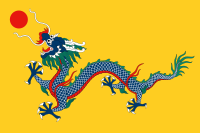|
Vikidia currently has 4,625 articles. Improve it! |
|
Join Vikidia: create your account now and improve it! |
Qing Dynasty
Qing Dynasty (Chinese: 清朝), was a dynasty from 1644 to 1912.
History[edit | edit source]

In the first half of the century he fought for control of Central Asia against the Oirates . Emperor Kangxi defeated their leader Galdan in 1696, but the Oirats returned with Galdan's nephew. Tibet was conquered in 1717 to secure influence in the center of Lamaism , as most Mongols belonged to this religion. Allied with a section in the Tibetan elite, the Qing dynasty expelled the invaders from Tibet, and placed them under Chinese sovereignty. Then, after numerous campaigns, Emperor Qianlong, who ruled for 60 years, destroyed the Oirate empire in 1750. Tarim basin after leaving the whole in their hands, China gained the largest expansion ever in 1759.
Throughout the century, tax breaks, investments in infrastructure, improvements in agricultural technology, and new plants from the Americas doubled the Chinese population, and the economy grew significantly. In southeastern China, in particular, specialized agriculture expanded and developed on an unprecedented scale, keeping it in survival agriculture with a minority of households. The bet on economic results was so great that China had ricehe finished importing the century. The living conditions and economic situation of Chinese farmers were much better than that of French farmers; one of the measures in favor of increasing the population was the use of food stored in warehouses, greatly reducing famines. The population grew so much in the middle of the empire that the migrations were very large to the outside of the empire, especially to the southeast. However, by the second half of the century, there was less and less additional food stored and new agricultural land, and it was more difficult to cope with population growth. The administration also had problems. Corruption spread among poorly paid local officials, who began to impose increasing taxes while reducing state services.The White Lotus uprising was of particular importance.
The industry also grew, both in number and in the size of these factories, as well as in the number of objects produced. In addition to the production of textiles, mining, and porcelain , tea processing was also an important industry. The sole purpose of some companies was to export. For example, some companies were meeting European demand because China was in vogue. XVIII. In the 16th century, China had strong trade with India, Europe, and Southeast Asia. From 1759 onwards, companies could only export through cantons or through authorized commercial enterprises. British Macartney Missions, he asked to liberalize trade, but the Emperor did not accept.
Along with economic and demographic growth, significant urbanization occurred. Beijing was the largest city in the world at the time. However, the population of the city accounted for only a small percentage of the total number. The city, however, was a vector of culture, with crafts, trade, writing, mobility and advertising. Women in the city also had new spaces to develop economic activity.
The Manchus of the Qing dynasty managed China in an authoritarian way. The system for selecting officials was fair to study, based primarily on knowledge of neo-Confucianism, which was the official ideology of the empire.

|
History Portal — All articles about history. |


